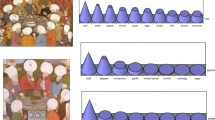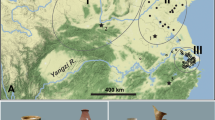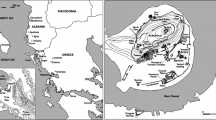Abstract
Archaeological Evidence of the Cultural Importance of Agave spp . in Pre-Hispanic Colima, Mexico. Production of agave-based food and fermented alcoholic beverages was highly relevant culturally and socially in pre-European contact western Mesoamerica. It has been hypothesized that agave distillation in western Mexico began in Colima in the early Colonial Era through adaptation of introduced Filipino techniques. Archaeological evidence is presented confirming the cultural and social significance of agave in Colima before contact, one of the fundamental conditions supporting this hypothesis. An analysis of circular subterranean stone structures in residential and ceremonial contexts (Classic and Postclassic periods: 200–1500 common era [CE]), and a comparison with stone ovens currently used to cook agave for the creation of spirits, indicate these structures were probably used for preparing food, including agave. Analysis of funerary ceramic vessel offerings with agave images (Colima phase: 400–600 CE) are reported for the first time. Their characteristics, and those of the associated burials and tombs, suggest those buried were agave growers or alcoholic beverage producers who fulfilled relevant roles in the society. Most of the agave images probably represent Agave angustifolia Lem and its cultivation. During the Colonial Era, the cultural and social relevance of agaves almost disappeared in Colima, possibly due to drastic reductions in the native human population, changing land use practices, and prohibitions against the production and sale of native alcoholic beverages.
Abstract
Evidencias Arqueológicas de la Importancia Cultural de Agave spp. en la Colima Pre-Hispánica, México. En el occidente de la Mesoamérica prehispánica, se elaboraban alimentos y bebidas alcohólicas fermentadas de agave con alta relevancia cultural y social. Se ha hipotetizado que en el occidente de México la destilación de agave se originó en Colima en la época Colonial temprana a través de la adaptación de las técnicas introducidas de Filipinas. Se presentan evidencias arqueológicas que confirman la importancia cultural y social de los agaves en Colima en la época precolombina, uno de los fundamentos de esta hipótesis. El análisis de estructuras circulares de piedra en contextos residenciales y ceremoniales (Clásico y Post-clásico: 200-1500 d.C.) y su comparación con hornos de piedra actualmente usados para cocer agaves para elaborar bebidas destiladas, indica que estas estructuras fueron probablemente usadas para preparar alimentos, incluyendo agaves. Se reportan por primera vez ofrendas funerarias de vasijas de cerámica con representaciones de agaves (Fase Colima: 400–600 d.C.). Sus características, y las de los entierros y tumbas asociados, sugieren que los personajes enterrados eran probablemente productores de agaves o de bebidas alcohólicas que tenían un papel relevante en la sociedad. La mayoría de las imágenes de agave son probablemente representaciones de Agave angustifolia Lem. y su cultivo. La relevancia cultural y social de los agaves en Colima decreció en la época Colonial hasta casi desaparecer, debido posiblemente al severo decremento de la población nativa, los cambios en las prácticas agrícolas, y las prohibiciones de elaborar y comercializar las bebidas alcohólicas nativas.








Similar content being viewed by others
Literature Cited
Alcade-de Rueda, J. 1580. Relación de parte de la Provincia de Motín. Pages 156–180 in R. Acuña, ed., 1987, Relaciones geográficas del siglo XVI: Michoacán. Universidad Nacional Autónoma de México. México DF, México.
Anderies, J. M., B. A. Nelson, and P. Kinzing. 2008. Analyzing the Impact of Agave Cultivation on Famine Risk in Arid Pre-Hispanic Northern Mexico. Human Ecology 36:409–422.
Beekman, C. S. 2006. The Chronological Context of the Central Jalisco Shaft Tombs. Ancient Mesoamerica 17:239–249.
Bruman, H. J. 1940. Aboriginal Drink Areas of New Spain. Ph.D. Dissertation in Geography in the Graduate Division of the University of California, Berkley, California.
———. 1945. Early Coconut Culture in Western Mexico. Hispanic American Historical Review 25:301–314.
———. 2000. Alcohol in Ancient Mexico. University of Utah, Salt Lake City, Utah.
Butterwick, K. 1998. Comida para los muertos: el arte de los banquetes en el Occidente. Pages 93–109 in R. Townsend, ed., El antiguo Occidente de México. Arte y arqueología de un pasado desconocido. The Art Institute of Chicago, Gobierno del Estado de Colima, México.
Callen, E. O. 1965. Food Habits of Some Pre-Columbian Mexican Indians. Economic Botany 19:335–343.
Capra, L. and J. L. Macías. 2002. The Cohesive Naranjo Debris-Flow Deposit (10 km3): A Dam Breakout Flow Derived from the Pleistocene Debris-Avalanche Deposit of Nevado de Colima Volcano (Mexico). Journal of Volcanic and Geothermal Research 117:213–235.
Colunga-GarcíaMarín, P. and D. Zizumbo-Villarreal. 2007. Tequila and Other Agave Spirits from West-Central Mexico: Current Germplasm Diversity, Conservation and Origin. Biodiversity and Conservation 16 (6): 1653–1667.
Dávila-Quiñonez, B. 1580. Relación de Quacomán. Pages 135–143 in R. Acuña, ed., 1987, Relaciones geográficas del siglo XVI: Michoacán. Universidad Nacional Autónoma de México. México DF, México.
de Agüero, F. 1579. Relación de Zapotitlán. Pages 57–82 in R. Acuña, ed., 1988, Relaciones geográficas del siglo XVI: Nueva Galicia. Universidad Nacional Autónoma de México. México DF, México.
de Arregui D. L. 1621. Descripción de la Nueva Galicia. in F. Chavalier, ed., 1946, Consejo Superior de Investigación Científica. Escuela de Estudios Hispanoamericanos, Sevilla, Spain.
Evans, S. T. 1992. Productivity of Maguey Terrace Agriculture in Central Mexico during the Aztec Period. Pages 92–115 in T. W. Killion, ed., Gardens of Prehistory: The Archaeology of Settlement Agriculture in Greater Mesoamerica. University of Alabama, Tuscaloosa, Alabama.
Fisher, C. T., H. P. Pollard, and C. Frederick. 1999. Intensive Agriculture and Socio-Political Development in the Lake Patzcuaro Basin, Michoacan, Mexico. Antiquity 73:642–649.
Flores-Hernández, B. A. 2007. Informe del análisis antropofísico realizado a los entierros procedentes del sitio: Loma Santa Bárbara (temporada 2007). Centro Regional Colima, INAH. Colima, México.
García, E. 1990. Climas, 1: 4000 000. IV.4.10 (A). Atlas Nacional de México, Vol. II. Instituto de Geografía, Universidad Nacional Autónoma de México. México DF, México.
Gentry, H. S. 1982. Agaves of Continental North America. University of Arizona, Tucson, Arizona.
Hodgson, W. C. 2001. Food Plants of the Sonoran Desert. The University of Arizona, Tucson, Arizona.
INEGI, 1998. Carta topográfica. escala 1:50 000 E3B44. Colima. 1:50000. México.
Jarquín, P. A. M. and E. Martínez-Vargas. 2004. Ritos y mitos prehispánicos nahuas en dos tumbas de La Campana, Colima. Estudios de Cultura Nahuatl 35:75–87.
Kelly, I. 1945. The Archaeology of the Autlán-Tuxcacuesco area of Jalisco. I. The Autlan Zone. Ibero-Americana No. 26. University of California, Berkeley-Los Angeles, California.
———. 1949. The Archaeology of the Autlán-Tuxcacuesco area of Jalisco. II. The Tuxcacuesco-Zapotitlán zone. Ibero-Americana No. 27. University of California, Berkeley-Los Angeles, California.
———. 1980. Ceramic Sequence in Colima: Capacha, An Early Phase. Anthropological Papers No. 37. University of Arizona, Tucson, Arizona.
López-Loera, H., J. Urrutia-Fucugauchi, J. L. Comparan-Elizondo, R. Castillo-Torres, R. Ponce-Juárez, A. M. Jarquín-Pacheco, and E. Martínez-Vargas. 2000. Magnetic study of archaeological structures in La Campana, Colima, Western Mesoamerica. Journal Applied Geophysics 43:101–116.
López-Mestas, L. C. and J. Ramos-de la Vega. 2006. Some interpretations of the Huitzilapa shaft tomb. Ancient Mesoamerica 17:271–281.
Luhr, J. S. and K. L. Prestegaard. 1988. Caldera Formation at Volcan Colima, Mexico, by a Large Holocene Volcanic Debris Avalanche. Journal of Volcanic and Geothermal Research 35:335–348.
Marcus, J. and K. V. Flannery. 2004. The Coevolution of Ritual and Society: New 14C Dates from Ancient Mexico. Proceedings of the National Academy of Science of the United States of America 101:18257–18261.
Morales, J. J. 1778. Descripción del curato de Ixtlahuacán. Pages 208–230 in J. A. Calderón-Quijano, ed., 1979, Documentos para la historia del Estado de Colima, siglos XVI–XIX. Ed. Novaro (Colección Peña Colorada), México DF.
Munsell. 1975. Munsell soil color charts. Munsell Color, Baltimore, Maryland.
Olay-Barrientos, M. A. 2004. El Chanal, Colima, lugar que habitan los custodios del agua. INAH-Universidad de Colima. México City, México.
——— and S. Mata. 2007. Informe técnico final de los trabajos de rescate arqueológico efectuados en la parcela 15Z-1 P1/3 del Ejido Villa de Álvarez, Colima. Chanal "P" (febrero-mayo 2001), Centro INAH-Colima, México.
Parker, K. C., L. Hamrick, W. C. Hodgson, D. W. Trapnell, A. J. Parker, and R. K. Kuzoff. 2007. Genetic consequences of Pre-Columbian cultivation for Agave murpheyi and A. delamateri (Agavaceae). American Journal of Botany 94:1479–1490.
Perry, L. and K. V. Flannery. 2007. Precolumbian Use of Chili Peppers in the Valley of Oaxaca, Mexico. Proceedings of the National Academy of Science of the United States of America 104:11905–11909.
Parsons, J. R. and J. A. Darling. 2000. Maguey (Agave spp.) Utilization in Mesoamerican Civilization: A Case for Pre-Columbian Pastoralism. Boletín de la Sociedad Botánica de México 66:81–91.
Rzedowski, J. and R. McVaugh. 1996. La vegetación de Nueva Galicia. University of Michigan. Ann Arbor, Michigan.
Sauer, C. 1948. Colima of New Spain in the Sixteenth Century. Ibero - Americana No. 1. University of California. Berkeley, California.
Sevilla-del Río, F. 1977. La Provança de la Villa de Colima. En su defensa ante un mandamiento de la Real Audiencia de México, que ordenaba la tala total de los palmares colimenses, año 1612. Editorial Jus, México DF, México.
Schöndube, B. O. 1973–1974. Tamazula, Tuxpan y Zapotlán: Pueblos de la frontera septentrional de la antigua Colima. 2 vol. Master in Archaeology Thesis. ENAH, México DF, México.
———. 1998. Recursos naturales y asentamientos humanos en el antiguo occidente. Pages 209-219 in R. Townsend, ed., Ancient West México: Art and Archaeology of the Unknown Past. Thames & Hudson in association with The Art Institute of Chicago, New York.
Smith, C. E. 1965. The Archaeological Record of Cultivated Crops of New World Origins. Economic Botany 19:322–334.
Trombold, C. D. and I. Israde-Alcántara. 2005. Paleoenvironment and Plant Cultivation on Terraces at La Quemada, Zacatecas, Mexico. The Pollen, Phytolith and Diatom Evidence. Journal of Archaeological Science 32:341–353.
Vela, E., ed. 2005. Tesoros de Colima: hallazgos de ayer y hoy. Arqueología Mexicana. Editorial Raíces. México DF, México.
Zizumbo-Villarreal, D. 1996. History of Coconut in Mexico. Genetic Resources and Crop Evolution 43:505–515.
——— and P. Colunga-GarcíaMarín. 2008. Early Coconut Distillation and the Origins of Mescal and Tequila Liquor in Western Mexico. Genetic Resources and Crop Evolution 55:493–510.
Acknowledgments
The authors thank P. Gepts for his hospitality at UC-Davis during a sabbatical for DZV and PCGM and the Consejo Nacional de Ciencia y Tecnología (CONACYT) fot the sabbatical scholarship.
Author information
Authors and Affiliations
Corresponding author
Additional information
Dedicated to Isabel Kelly in honor of her contributions to the understanding of cultural development in western Mexico and Colima in particular.
Rights and permissions
About this article
Cite this article
Zizumbo-Villarreal, D., González-Zozaya, F., Olay-Barrientos, A. et al. Archaeological Evidence of the Cultural Importance of Agave spp. in Pre-Hispanic Colima, Mexico. Econ Bot 63, 288–302 (2009). https://doi.org/10.1007/s12231-009-9092-5
Received:
Accepted:
Published:
Issue Date:
DOI: https://doi.org/10.1007/s12231-009-9092-5




